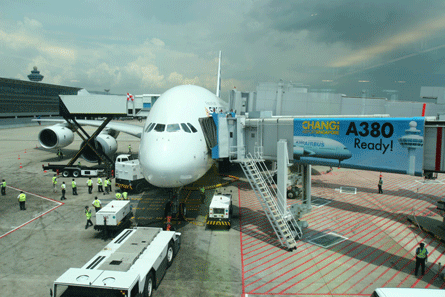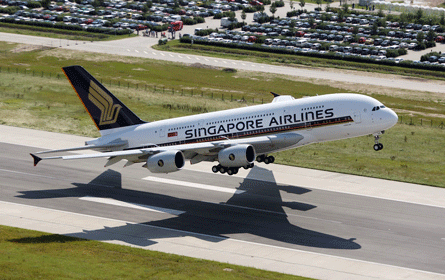History will be made next week when Singapore Airlines puts its first Airbus A380 into revenue service. The airline, along with the ultra-large aircraft's manufacturer and key suppliers, have put in maximum effort to ensure the inaugural is remembered only for the right reasons.
Not only is the A380 the largest airliner ever to enter service, it is also the most complex. But Airbus is confident that the A380's advanced technology will help rather than hinder the aircraft's early reliability.
SIA's 471-seat A380s will carry 30% more passengers than its 370-seat 747-400s - and with just one A380 being delivered this year, this means that the airline has no easy back-up solution should a flight have to be cancelled. To add yet more pressure, SIA intends to fly the aircraft on regular daily flights between Singapore and Sydney right from the start, with 6h stop-overs at its home base, but just 100min transits at the destination. "SIA's level of confidence is so high that they've taken the decision to do this. We now have to deliver reliability," says Philippe Mhun, Airbus vice-president customer services on the A380.
|
|---|
When the first SIA A380 enters service next week, it will be monitored all the way to Sydney by an Airbus technical team in Toulouse |
AVOIDING PAST MISTAKES
Airbus undertook its last major introduction of a new type in 2002 - the A340-600 - and the airframer is the first to admit that this was not its finest hour as the quad-jet's reliability took too long to reach acceptable levels. As part of the rethink to ensure it did not repeat previous mistakes, Airbus recruited Mhun from Air France in November 2004. At Air France Mhun had been head of long-haul fleet engineering and maintenance. He says the difference this time with the preparation for the A380's service entry is that "Airbus is trying to behave in an airline mindset. The key word is 'anticipation'".
Click on image to enlarge |
Airbus has worked through a multi-point plan to ensure the A380 and the launch airline are both service ready, and that it has the necessary processes in place should the inevitable technical problem occur. The plan comprises an operational readiness campaign that included the systems test benches as well as the validation of the aircraft under airline conditions training the airline's personnel ensuring that the required tools and spares are in place and finally a fully integrated real-time support network across the globe that will cosset the aircraft during early operations.
Twenty SIA flightcrew and 48 engineers have been through Toulouse for A380 training. The airline has ordered over 1,500 A380 spares, and more than 35 suppliers are participating in the "virtual warehouse". This is a database that can provide information on the availability of A380 spares worldwide, and can be interrogated automatically by the aircraft via satellite while it is airborne.
The programme delays did not cause much disruption to the A380's certification schedule which remained well ahead of the production effort, with approval being granted in December last year. This has given Airbus 10 months to concentrate on proving the aircraft for service, and enabled it to generate an unprecedented number of flying hours for an aircraft ahead of service entry. The 10 A380s that have flown to date - including five development aircraft - have accumulated over 4,400h in the air and almost 3,400 take-offs.
"The idea was to convert the programme delay into extra operational readiness," says Mhun. Much of this time has been used for "maturity validation", where the aircraft flew specific "maturity weeks" per airline procedures. "Each technical issue that has arisen during the development phase that could create a problem for operability and reliability has an individual 'identity card'," says A380 programme chief Mario Heinen. "This describes the nature of problem, the root cause and technical fix, and is used for transparency and strict follow-up until the problem is solved and the improvements are installed on the aircraft."
To maximise the reliability of the A380, Airbus has evaluated more than 5,000 findings from technical issues that arose both on the flight-test aircraft and on the test benches, and evaluated which failures could have an impact on the operation of the aircraft. "We identified 500 topics that needed a focused approach," says Mhun. "We established the time needed to get a fix, and where we were not successful in getting the proper modification we set up a mitigation plan - for example provisioning some extra spares or implementing specific flight operations procedures."

Mhun is confident this exercise has given Airbus full coverage of any key technical issue, either through a pre-delivery modification or a mitigation action, for SIA's A380s.
The flight-test aircraft and test benches were used for more than 700 "operability test scenarios" in six clusters: ground handling flight operations scheduled and unscheduled maintenance robustness (including the cabin) and engineering support.
ENHANCED SUPPORT
Airbus has developed an "enhanced support" package that has a two-axis working principle designed firstly to minimise the impact of a technical problem on the aircraft's operations, and secondly to identify in-service problems quickly to minimise the time required to develop a fix. "Early on it became clear that SIA would not have a back-up aircraft during the initial operation. And we knew we would experience some technical events," says Mhun.
With no back-up aircraft available, Airbus is acutely aware that any "no-go item" could result in the airline having to find hotel rooms for up to 470 passengers, so it is vital that the wheels are set in motion to deal with such events as soon as they emerge. The Airbus Technical AOG (aircraft-on-ground) Center (AIRTAC) in Toulouse will monitor the behaviour of the SIA A380 24h a day in real time. "As soon as we know during a flight to Sydney that we will have a potential no-go when we arrive, we can start preparing," says Mhun. "The idea is to use the knowledge captured during the flight-test campaign to recommend maintenance actions to SIA in a proactive way, sometimes even before it is aware that there is a technical event on the aircraft."
Airbus has agreements in place with suppliers that they have to have one stock of AOG spares located each in the USA, Europe and Asia. "It was easier in the first step to locate the spares on SIA's initial network," says Mhun. "From our analysis of potential no-go items, we have been securing spares in Sydney."
Engineers from the Airbus design office, its support department and from certain suppliers will be co-located to enable quick troubleshooting of technical events, followed by advocacy of the solution.
Engineers will be on standby "24h a day, seven days a week", and Airbus also has representatives from 35 critical suppliers in Toulouse that it can call upon, as required.
CONTROL CENTRE
SIA has set up a dedicated A380 control centre in Singapore, which will be supported by AIRTAC along with "almost 30" Airbus staff deployed to the airline's base to assist. A full team of Airbus engineers - including systems experts and mechanics experienced from the flight-test programme - will be positioned in Singapore to support the early operations. Airbus has doubled the normal number of local support representatives, and will have some mechanics in Sydney.
"The idea is that the mechanics will coach the SIA mechanics, but they will also be able to assist if we have to perform a very quick modification," says Mhun.
The technical experts will be on site to assist with new systems on the aircraft, such as its network server system and electrical generation system. The A380 flight-test aircraft manager will also be in Singapore.
During early operations, the Airbus and SIA engineering teams will hold three daily meetings - one in Sydney and one in Singapore each about 1.5h before the aircraft lands, to assess any critical tasks required to be sure it can depart on time, and a third conference call in Toulouse between the key "stakeholders" at SIA and Airbus to review all the critical items, chaired by Mhun. "We'll do this until we achieve an acceptable level of reliability from our customer's standpoint," he says.
SIA will have an Airbus pilot on the flightdeck during initial operations, as is normal with the introduction of any new aircraft, but it is not planned for any additional engineering support to travel on the A380 flights.
Airbus is confident the 100min transits in Sydney will be handled comfortably, having validated the A380's 90min turnaround target during the route-proving and long-haul campaigns. The optimum turnaround configuration is to have the A380 served by three air bridges - two to the main deck and one to the upper deck. SIA's Changi base has "several" three-air-bridge stands ready, says Heinen.
CATERING METHODS
Airbus "strongly recommends" that A380 operators replenish the upper-deck galleys using the upper-deck doors, although this requires specialised scissor trucks capable of reaching the door sills which are around 8m (26ft) above the tarmac. The process can be undertaken using the main deck only, with standard 747-type catering vehicles and moving the containers to the upper deck via catering lifts. SIA will be using upper-deck catering replenishment at both Singapore and Sydney.

The catering process is by far the longest component of the A380 turnaround timing, as it is on the 747. "Distributing the huge number of containers and trolleys across all the galleys on the main and upper decks in the different areas is the critical path that ultimately determines length of the turnaround," says Heinen.
"SIA is not planning to stop the first aircraft for any maintenance activity before the arrival of the second aircraft next year," says Mhun. "So the A check, for example, which has a 750h interval, will be broken into three or four packages consistent with the 6h turnaround in Singapore."
Airbus knows that although it has done everything in its power since the A380 programme began to ensure that the aircraft has the best introduction ever, it is acutely aware that there are certain to be some "unknown unknowns" that will only become clear once the aircraft has built up some operational experience. By March 2008 SIA's A380 fleet is expected to have exceeded the 4,000h accumulated by the development aircraft during the flight-test programme. "This is when we will enter a period where we could detect new issues not discovered during flight testing and bench testing," says Mhun. "We will have a good understanding of what the critical issues are."
The next two customer to receive the A380 will be Emirates and Qantas - the former being the first to take the Engine Alliance GP7200-powered version, with deliveries due to begin in summer next year.
Source: Flight International


















